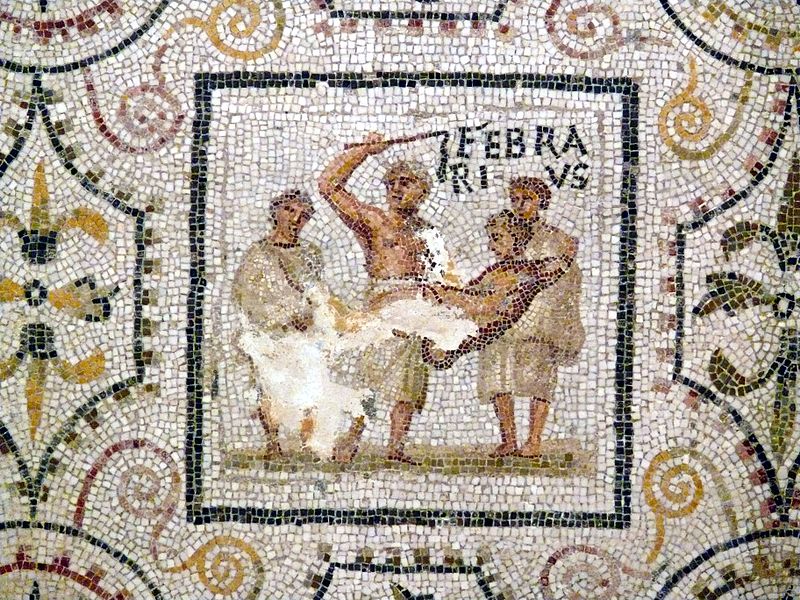Februarius, the month of purification
Published on 16 February 2020Reading time: 8 minutes

Archeological Museum of Sousse © Ad Meskens / Wikimedia Commons |
February in the Roman calendar
Several months are named after Roman gods. March, the first month of the year in the old Roman calendar, is in honor of the god of war, Mars. May is in honor of the goddess Maia, the goddess of spring and plants, while June is in honor of the goddess Juno. Juno is the wife of Jupiter. Jupiter is the god of light and sky and the protector of the state and its laws. July is in honor of Julius Caesar, and August is in honor of Augustus, the first emperor of the Roman Empire (reign: 27 BC – 14 AD).
January is in honor of the god Janus, the god of the beginning and the end. February, from Latin Februarius, was the last month of the year in the ancient Roman calendar. It was introduced by Numa Pompilius (reign: 715–673 BC), who also introduced the month of January (from Latin Ianuarius), the previous Roman calendar consisting of only ten months. Ten months indeed: September (from septem, seven in Latin) was the seventh month of the year, October (from octo or eight in Latin) was the eighth month of the year, November (from novem or nine in Latin) was the ninth month of the year, December (from decem or ten in Latin) was the tenth and last month of the year in the old Roman calendar.
February is a truly peculiar month: it is the shortest month of the year, and it is the only month to have a leap day: February 29th. This month has been used throughout history to deal with synchronization with the solar year. Before the Julian calendar, it was reduced to February 23rd, when the intercalary month Mercedonius was added to the Roman calendar to deal with the problem of synchronization. The problem of synchronization was solved once and for all by Pope Gregory XIII, who introduced the Gregorian calendar in 1582: the leap day was removed for years evenly divisible by 100 but not evenly divisible by 400.
The religious meaning of the month of Februarius
The word Februarius is derived from the word februum, an object used for ritual purification, noting that februum is related to the word febris, which means to burn or warm. February was, therefore, about burning and cleansing. Being the last month of the year (and often the coldest) in the ancient Roman calendar, many of the religious observances in mensis Februarius were also about the dead or closure.The Parentalia was a nine-day festival beginning on February 13th, honoring family ancestors and propitiating the dead. Because it was supposed to indicate a period of public mourning, all marriages of any kind were forbidden. Temples were closed, and any worship of the gods was prohibited. Ovid writes: "no incense on the altar, no fire on the hearth."1 Magistrates stopped wearing their insignia, indicating that the Romans could not conduct any official business.
On the opening day of Parentalia on February 13th, a Vestal conducted a rite for Rome's ancestors (the Manes) at the tomb of Tarpeia. On the last day of the festival, on February 21st also called the day of Feralia, the Romans would make sacred offerings at family tombs located outside of Rome's sacred boundary (pomerium). According to Ovid, these offerings to the "shades of the dead" consisted of flower garlands, violets, wheat, salt, and wine-soaked bread. There were meant to strengthen the bonds between the living and the dead. Ovid also mentions a time when the Romans neglected Feralia amid war, which arose the spirits of the deceased from their grave, the spirits then howling in anger and roaming the city's streets. On the following day, the day of Caristia, the family held an informal banquet to celebrate the bond between themselves and their family ancestors.
Lupercalia was another religious festival between February 13th and 15th whose purpose was to expel the evil spirits and purify the city, thereby bringing health and fertility. In honor of the God Lupercus whose statue stood in the Lupercal, the cave is located at the foot of the Palatine Hill, where according to legend Romulus and Remus were suckled by the she-wolf Lupa.
Lupercalia was originally a ritual to protect livestock, mainly sheep and goats, from wolves' depredations.2 The ritual was also intended to safeguard the fertility and lactation of herd animals from unseen hostile forces. The fertility of herd animals was extended to include the fecundity of humans: after sacrificing a goat, the Luperci or the priests of this festival, wearing only thongs of goat-skin in imitation of the god Lupercus, would run about the city and strike women with strips of the same goat skin, thereby transferring the goat’s fertility to the women. It is worth noting that when Rome later adopted Christianity, Pope Gelasius I (494-496 AD) considered Lupercalia a vile festival and sought to abolish it. But the senate, so attached to the festival and so afraid of the consequences of not respecting it, protested and insisted that Lupercalia was essential to Rome's well-being and safety. Therefore, the festival kept taking place for a certain period of time, even under Christianity.
Terminalia was a festival held on February 23rd or the last day of the month in the ancient Roman calendar: when the intercalary month Mercedonius (or Mensis Intercalaris) was added to the Roman calendar to deal with the problem of synchronization, the last five days of Februarius were added to the intercalary month, making the 23rd of February the last day of the year. Terminalia was in honour of the god Terminus, the god of boundaries. Terminus' statue was merely a stone or post firmly planted on the ground that was used to separate properties. During Terminalia the owners of adjacent properties crowned the statue with garlands and raised an altar on which they sacrificed a lamb or a suckling pig or placed some corn, honeycombs and wine. Terminalia was not only about separation of properties but also about closure, about marking the end of the year and about clearly putting the year passed, behind.

Hieronymus Bang (1573-1630) CC-PD-Mark |
The Roman calendar also had a lot to do with agriculture and the Romans’ agrarian way of life. Calendars were initially used to plan for agricultural cycles and to organize days for religious, administrative and commercial purposes. For example, the beginning of the year in the old Roman calendar (in the month of March) was also the beginning of the agricultural season. The last day of the week in the calendar was the day when farmers came to the city's market to sell their products.
During the month of February, no agriculture would be taking place. However farmers would weed the grain fields and burn old reeds. According to agricultural writer Columella, the meadows and grain fields were purged (purguntur) by clearing away debris and old grass.3 This practice of burning the fields (febris means to burn in Latin) would make the soil more fertile and would also eliminate pest species from it, thereby improving the health of the fields.
Conclusion
February for the Romans was a month of purification, a month when farmers would burn their fields and when evil spirits would be expelled from the city. It was also about bringing back health and fertility to the fields and to families. It was also the month of the dead and closure, when the bonds between the living and the dead would be strengthened. Finally, it was about marking the end of the year in order to start... a new one.SOURCES
YOU MAY ALSO LIKE
Return from Februarius to Homepage

